Maiji Mountain Grottoes in NW China's Gansu
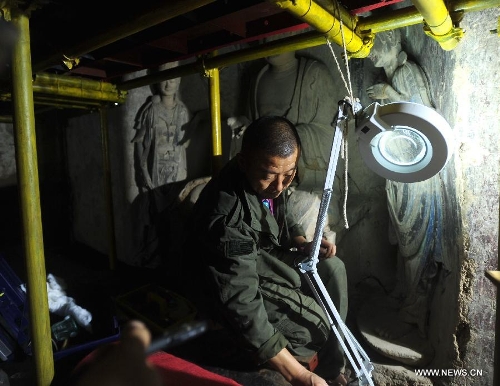
A worker repairs a sculpture at the Maiji Mountain Grottoes in Tianshui, northwest China's Gansu Province, July 15, 2013. After protection and preparation, the Maiji Mountain Grottoes, the fourth largest grottoes in China and known as the "Oriental Sculpture Museum", has been ready for the application for status on the World Heritage List in 2014, as a part of the application program of the 2,000-year-old Silk Road which China works with Kazakstan and Kyrgyzstan and was officially submitted to the United Nations Educational, Scientific and Cultural Organization (UNESCO) in January of 2013. China has altogether 22 historical sites in this application program, including seven in Xinjiang, five in Gansu, six in Shaanxi and four in Henan. Photo: Xinhua
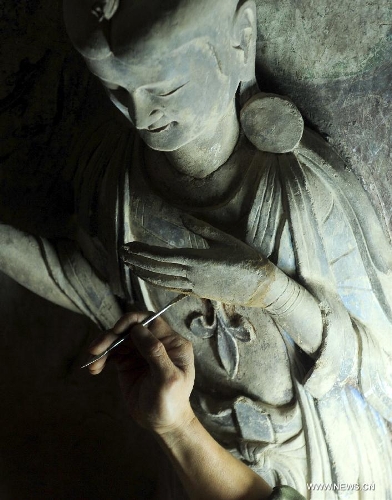
A worker repairs a sculpture at the Maiji Mountain Grottoes in Tianshui, northwest China's Gansu Province, July 15, 2013. After protection and preparation, the Maiji Mountain Grottoes, the fourth largest grottoes in China and known as the "Oriental Sculpture Museum", has been ready for the application for status on the World Heritage List in 2014, as a part of the application program of the 2,000-year-old Silk Road which China works with Kazakstan and Kyrgyzstan and was officially submitted to the United Nations Educational, Scientific and Cultural Organization (UNESCO) in January of 2013. China has altogether 22 historical sites in this application program, including seven in Xinjiang, five in Gansu, six in Shaanxi and four in Henan. Photo: Xinhua
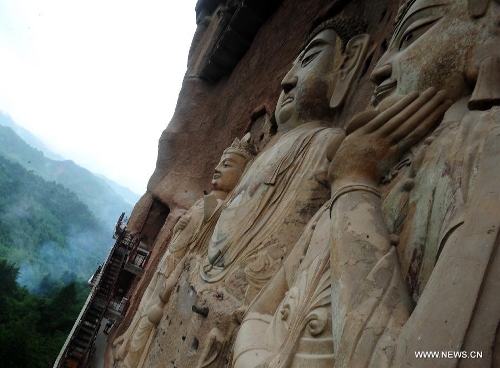
Photo taken on July 15, 2013 shows sculptures on the cliff of the Maiji Mountain Grottoes in Tianshui, northwest China's Gansu Province. After protection and preparation, the Maiji Mountain Grottoes, the fourth largest grottoes in China and known as the "Oriental Sculpture Museum", has been ready for the application for status on the World Heritage List in 2014, as a part of the application program of the 2,000-year-old Silk Road which China works with Kazakstan and Kyrgyzstan and was officially submitted to the United Nations Educational, Scientific and Cultural Organization (UNESCO) in January of 2013. China has altogether 22 historical sites in this application program, including seven in Xinjiang, five in Gansu, six in Shaanxi and four in Henan. Photo: Xinhua
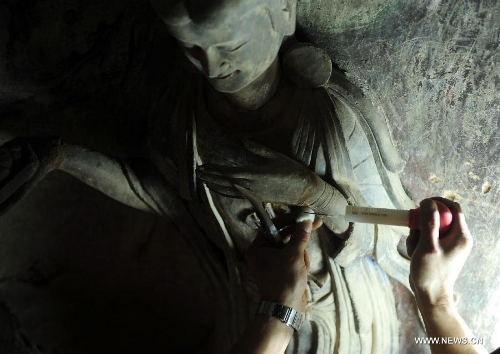
A worker repairs a sculpture at the Maiji Mountain Grottoes in Tianshui, northwest China's Gansu Province, July 15, 2013. After protection and preparation, the Maiji Mountain Grottoes, the fourth largest grottoes in China and known as the "Oriental Sculpture Museum", has been ready for the application for status on the World Heritage List in 2014, as a part of the application program of the 2,000-year-old Silk Road which China works with Kazakstan and Kyrgyzstan and was officially submitted to the United Nations Educational, Scientific and Cultural Organization (UNESCO) in January of 2013. China has altogether 22 historical sites in this application program, including seven in Xinjiang, five in Gansu, six in Shaanxi and four in Henan. Photo: Xinhua
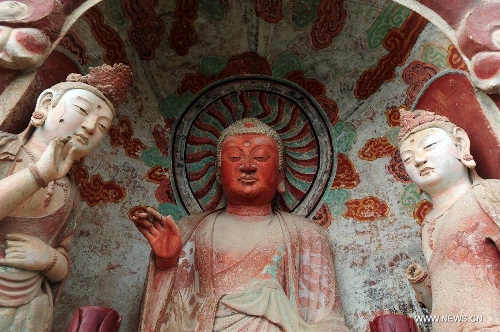
Photo taken on July 15, 2013 shows sculptures at the Maiji Mountain Grottoes in Tianshui, northwest China's Gansu Province. After protection and preparation, the Maiji Mountain Grottoes, the fourth largest grottoes in China and known as the "Oriental Sculpture Museum", has been ready for the application for status on the World Heritage List in 2014, as a part of the application program of the 2,000-year-old Silk Road which China works with Kazakstan and Kyrgyzstan and was officially submitted to the United Nations Educational, Scientific and Cultural Organization (UNESCO) in January of 2013. China has altogether 22 historical sites in this application program, including seven in Xinjiang, five in Gansu, six in Shaanxi and four in Henan. Photo: Xinhua
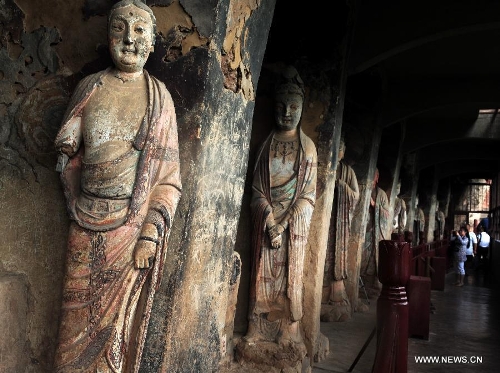
Photo taken on July 15, 2013 shows sculptures at the Maiji Mountain Grottoes in Tianshui, northwest China's Gansu Province. After protection and preparation, the Maiji Mountain Grottoes, the fourth largest grottoes in China and known as the "Oriental Sculpture Museum", has been ready for the application for status on the World Heritage List in 2014, as a part of the application program of the 2,000-year-old Silk Road which China works with Kazakstan and Kyrgyzstan and was officially submitted to the United Nations Educational, Scientific and Cultural Organization (UNESCO) in January of 2013. China has altogether 22 historical sites in this application program, including seven in Xinjiang, five in Gansu, six in Shaanxi and four in Henan. Photo: Xinhua
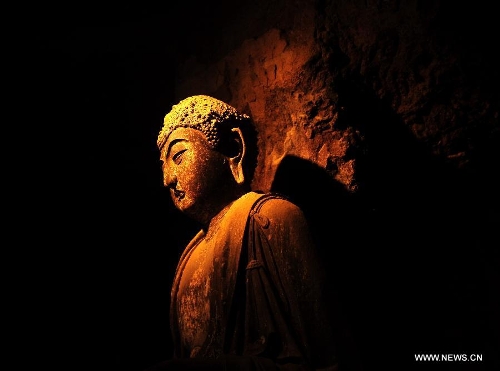
Photo taken on July 15, 2013 shows a sculpture at the Maiji Mountain Grottoes in Tianshui, northwest China's Gansu Province. After protection and preparation, the Maiji Mountain Grottoes, the fourth largest grottoes in China and known as the "Oriental Sculpture Museum", has been ready for the application for status on the World Heritage List in 2014, as a part of the application program of the 2,000-year-old Silk Road which China works with Kazakstan and Kyrgyzstan and was officially submitted to the United Nations Educational, Scientific and Cultural Organization (UNESCO) in January of 2013. China has altogether 22 historical sites in this application program, including seven in Xinjiang, five in Gansu, six in Shaanxi and four in Henan. Photo: Xinhua
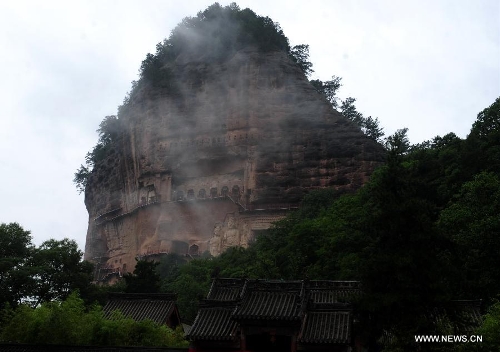
Photo taken on July 15, 2013 shows the scenery at the Maiji Mountain Grottoes in Tianshui, northwest China's Gansu Province. After protection and preparation, the Maiji Mountain Grottoes, the fourth largest grottoes in China and known as the "Oriental Sculpture Museum", has been ready for the application for status on the World Heritage List in 2014, as a part of the application program of the 2,000-year-old Silk Road which China works with Kazakstan and Kyrgyzstan and was officially submitted to the United Nations Educational, Scientific and Cultural Organization (UNESCO) in January of 2013. China has altogether 22 historical sites in this application program, including seven in Xinjiang, five in Gansu, six in Shaanxi and four in Henan. Photo: Xinhua
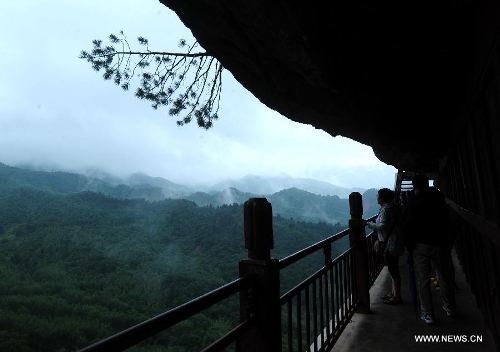
People visit the Maiji Mountain Grottoes in Tianshui, northwest China's Gansu Province, July 15, 2013. After protection and preparation, the Maiji Mountain Grottoes, the fourth largest grottoes in China and known as the "Oriental Sculpture Museum", has been ready for the application for status on the World Heritage List in 2014, as a part of the application program of the 2,000-year-old Silk Road which China works with Kazakstan and Kyrgyzstan and was officially submitted to the United Nations Educational, Scientific and Cultural Organization (UNESCO) in January of 2013. China has altogether 22 historical sites in this application program, including seven in Xinjiang, five in Gansu, six in Shaanxi and four in Henan. Photo: Xinhua
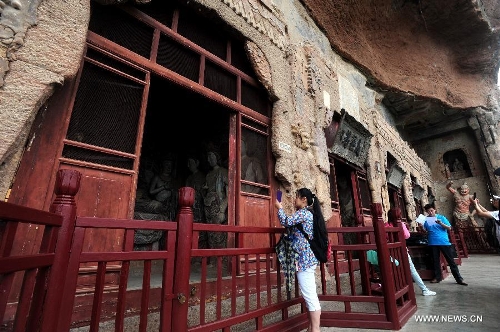
People visit the Maiji Mountain Grottoes in Tianshui, northwest China's Gansu Province, July 15, 2013. After protection and preparation, the Maiji Mountain Grottoes, the fourth largest grottoes in China and known as the "Oriental Sculpture Museum", has been ready for the application for status on the World Heritage List in 2014, as a part of the application program of the 2,000-year-old Silk Road which China works with Kazakstan and Kyrgyzstan and was officially submitted to the United Nations Educational, Scientific and Cultural Organization (UNESCO) in January of 2013. China has altogether 22 historical sites in this application program, including seven in Xinjiang, five in Gansu, six in Shaanxi and four in Henan. Photo: Xinhua
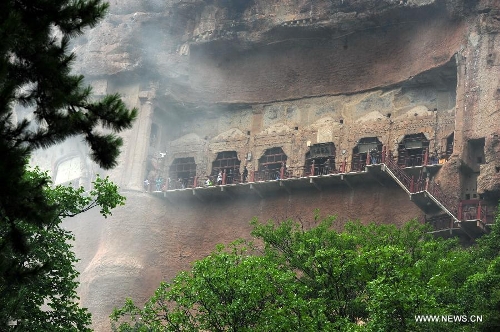
Photo taken on July 15, 2013 shows the scenery at the Maiji Mountain Grottoes in Tianshui, northwest China's Gansu Province. After protection and preparation, the Maiji Mountain Grottoes, the fourth largest grottoes in China and known as the "Oriental Sculpture Museum", has been ready for the application for status on the World Heritage List in 2014, as a part of the application program of the 2,000-year-old Silk Road which China works with Kazakstan and Kyrgyzstan and was officially submitted to the United Nations Educational, Scientific and Cultural Organization (UNESCO) in January of 2013. China has altogether 22 historical sites in this application program, including seven in Xinjiang, five in Gansu, six in Shaanxi and four in Henan. Photo: Xinhua
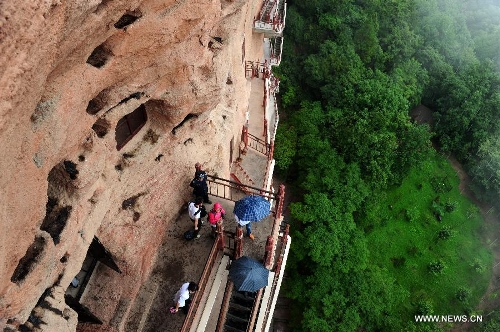
People visit the Maiji Mountain Grottoes in Tianshui, northwest China's Gansu Province, July 15, 2013. After protection and preparation, the Maiji Mountain Grottoes, the fourth largest grottoes in China and known as the "Oriental Sculpture Museum", has been ready for the application for status on the World Heritage List in 2014, as a part of the application program of the 2,000-year-old Silk Road which China works with Kazakstan and Kyrgyzstan and was officially submitted to the United Nations Educational, Scientific and Cultural Organization (UNESCO) in January of 2013. China has altogether 22 historical sites in this application program, including seven in Xinjiang, five in Gansu, six in Shaanxi and four in Henan. Photo: Xinhua